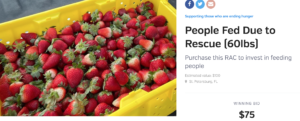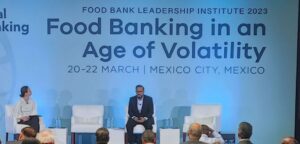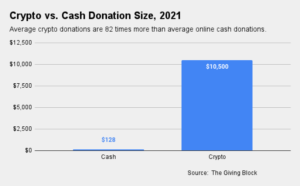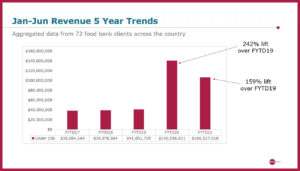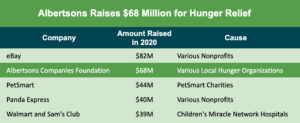Food banks have long depended on private donations from individuals to function, and the size of those donations followed trends that were consistent for years – until Covid-19 happened.
The pandemic has elevated cash donations to a new, much higher level. RKD Group, a fundraising and marketing provider, analyzed donations to 80 food banks around the country over the past three years to find that giving increased by 127% between 2019 and 2021, from $143 million to $326 million.
“While the pandemic was big, for food banks especially, it is part of their history now,” said Tonie Howard, Senior Vice President at RKD.
In another positive sign, new donors are continuing to come on board, with new donor counts up 87% in 2021 compared to 2019, to 321,000. At the same time, people who were new donors in 2020 evolved into second-year donors in 2021. Between 2020 and 2021, the number of second-year donors more than tripled to 254,000.
“When Covid hit, a lot of our clients doubled or tripled their size of the donor base. If someone had, say, 10,000 donors, they were now looking at 30,000 to 35,000,” said Ann Dunn, Senior Vice President at RKD. “Many of these donors have stayed on even after the pandemic has waned.”
All that spells good news, given the ongoing need to distribute elevated amounts of food. Feeding America last week reported that 65% of the 200 food banks in its network experienced an increase in the demand for food in June compared to May, due to sharply rising inflation. And there are other pressures: 70% said in an earlier survey that food donations are down, while 95% said that food purchase costs are up.
Given these trends, cash donations from individuals may be a rare bright spot. To be clear, cash donations are down from the early days of the pandemic when long lines at food banks prompted unprecedented giving. But giving to food banks is significantly up from its pre-pandemic level and is expected to remain so for the foreseeable future.
Michael McKee, CEO of Blue Ridge Area Food Bank, said that donations to his food bank hit a peak during 2020 and are coming in this year at lower levels. But he expects them to level off at an amount that will be significantly higher than pre-pandemic.
Before 2019, Blue Ridge Area Food Bank averaged about $6.5 million in charitable contributions annually. This year the food bank expects to generate about $11.5 million in donations and perhaps slightly less next year. “Even if we level off at between $10 million and $12 million per year, that’s still a whole heck of a lot more than before the pandemic,” McKee said.
He expects the extra support will foster programming that goes well beyond emergency food distribution to include initiatives like food pharmacies, benefits outreach, collaborations with health care providers, and senior outreach. “Three years ago, we would have had to pick one” initiative, he said. “Now we can deliver more value to the community.”
Food banks appear to have overcome one of the main challenges related to so-called “disaster giving,” which is that it often results in a one-time donation. “We thought these donations would be what we call transactional-type gifts, where they donate once, and that’s it,” Howard said. “But then we noticed these people were becoming monthly sustainers.
Food bank donors are also getting younger. Data from 2013 to 2014 show that the largest portion of donors then (38%) were 75 or older. Now that percentage is down to 26%. Meanwhile, the biggest gains in donors have been made among age groups that are 64 years and younger.
Dunn attributed this shift to the emergence of technology in the food bank marketing space. “A mentor of mine told me 30 years ago that all our clients want younger donors, they just have to wait 20 years, and they will have them. What he meant and what we are saying is digital means need time to mature, and now it has. It has exploded for food banks, and they now see the benefits of digital fundraising,” said Dunn.
Digital will take more of a central role in food bank marketing, especially as donors continue to skew younger. “Digital is definitely the big news,” Dunn said. “In the past, donors were approached through direct mail. But now, digital means and social media have brought in significant revenues. This is not to say that direct mail is obsolete. I don’t think it will be because people still like to have a sentimental value to their actions.”
Howard agreed about the power of digital marketing. “Digital is going to take over more and more. Younger people are looking for a cause to stand behind, and they will, I think, gravitate toward hunger in America.” – Aryan Rai
Aryan Rai is a graduate student of journalism at Boston University.
Like what you’re reading?
Support Food Bank News
This article was made possible by the readers who support Food Bank News, a national, editorially independent, nonprofit media organization. Food Bank News is not funded by any government agencies, nor is it part of a larger association or corporation. Your support helps ensure our continued solutions-oriented coverage of best practices in hunger relief. Thank you!
Connect with Us:

